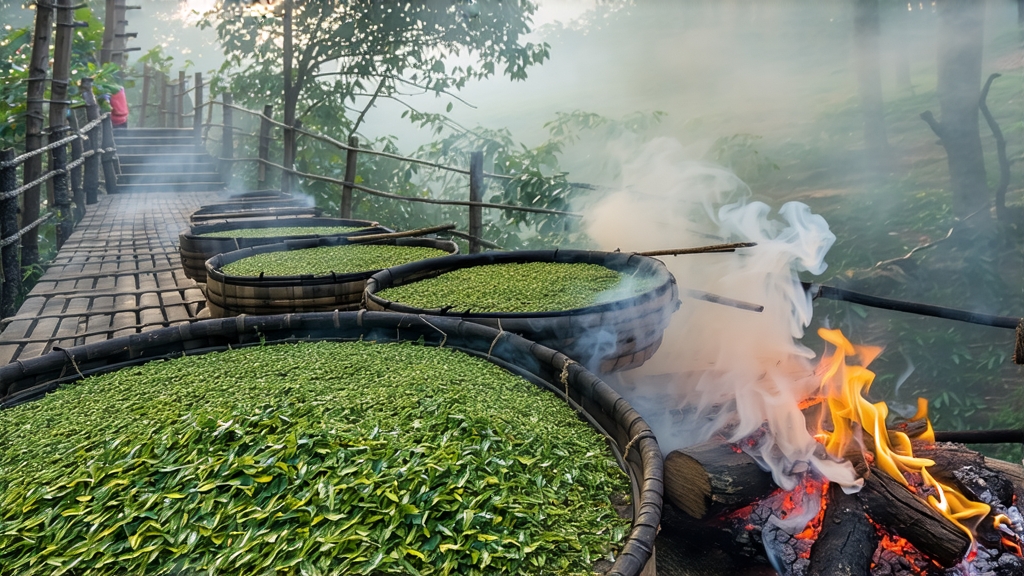
Lapsang Souchong—often written in the West with a French flourish—was born in the rocky folds of the Wuyi Mountains of northern Fujian province. Local chronicles date its creation to the late Ming dynasty, around 1604, when passing armies forced tea farmers to speed-dry freshly plucked leaves over open pine fires so that the crop could be rushed to market before the soldiers arrived. The accidental marriage of tea and resinous smoke created an aroma so compelling that Dutch traders carried it to Europe, where it became the first black tea ever seen in London coffee-houses. In doing so, Lapsang Souchong established the very category we now call “black tea,” a term the Chinese still consider curious because they describe the leaf as “red” (hong) for the color of its liquor, not its leaf.
Geographically, the authentic leaf must come from the original 600-square-kilometer core of the Wuyi Nature Reserve, an UNESCO biosphere whose mineral-rich, weathered igneous soils force the tea bushes—predominantly the small-leaf Bohea cultivar—to grow slowly, concentrating aromatic compounds. Within this micro-region, only the highest, mist-shrouded plots known as “zhengshan” (true mountain) may legally sell their tea as Zheng Shan Xiao Zhong, the protected origin name. Leaves picked below 500 m, or from neighboring counties, are labeled “waishan” (outside mountain) and lack the sweet, longan-fruit depth that defines the original.
The plucking standard is two leaves and a bud, taken in late April when the spring sap rises. Once picked, the leaves are withered on bamboo trays set over dying ember trenches; the gentle warmth coaxes moisture away while the pine smoke drifts upward, coating the still-green leaf in a invisible film of resin. After four to six hours, when the leaf feels leathery, workers roll it by hand on rattan mats, breaking cell walls so that enzymes can react with oxygen. Oxidation proceeds inside wooden chests lined with wet cloth; here the leaf turns from jade to copper, developing malty notes that balance the forthcoming smoke. Finally, the tea is pan-fired at 90 °C, then hot-smoked a second time above fresh pine logs. Master craftsmen judge the exact moment by sniffing the rising steam; too short and the fragrance is thin, too long and it becomes harsh, like burnt tire rubber.
Western palates usually meet two stylistic expressions. The traditional “smoked” style exports a bold, campfire aroma that pairs surprisingly well with milk and sugar, a habit inherited from seventeenth-century British merchants. Inside China, however, the newer “unsmoked” or “fruit-style” Zheng Shan Xiao Zhong has become fashionable: the same leaf is processed without the final pine firing, yielding a honeyed cup reminiscent of dried longan, cocoa, and roasted sweet potato. Both styles share a silky texture and a lingering mineral finish that echo the Wuyi cliffs themselves.
To brew either version gongfu style, begin with 5 g of leaf in a 120 ml porcelain gaiwan. Rinse once with 95 °C water, then steep successively for 5, 7, 10, 15, 25 and 40 seconds, adding five seconds to each later infusion. The smoked tea will open with resinous top notes that quickly give way to a core of dark chocolate and ripe plum; the unsmoked style leads with caramelized sugar and orchid fragrance, finishing on wet stone. Western teapot drinkers may use 2.5 g per 250 ml, three minutes at the same temperature, though the layered evolution will be less dramatic.
Professional cupping follows ISO 3103 standards but adds a “smoke-cool” test: after the liquor is decanted, the wet leaf is spread on a white porcelain plate and sniffed cold. A premium Lapsang Souchong will show no ashy off-odors; instead, the cooled aroma should recall a pine forest after rain, sweet and balsamic. Liquor color is judged under north daylight: smoked versions pour a clear mahogany, while unsmoked lots glow amber-orange. Slurp loudly across the palate to aerate; the finish should last at least thirty seconds, with a cooling sensation at the back of the throat that the Chinese call “sheng jin” (literally “producing fluid”).
Storage is critical. Because the smoked leaf continues to absorb ambient odors, it must be sealed in opaque, resealable